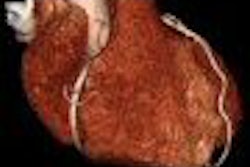When the benefits of incidental findings outside the colon are included, virtual colonoscopy (VC or CT colonography [CTC]) is more cost-effective than conventional colonoscopy, according to the results of a model-based analysis published Monday in the Archives of Internal Medicine.
The study showed that conventional colonoscopy saved more lives than VC from colorectal cancer owing to its higher sensitivity for colorectal lesions. But VC more than made up for the difference by preventing deaths due to abdominal aortic aneurysm (AAA). On the other hand, VC's ability to detect extracolonic cancers didn't affect the results much.
Most incidental VC findings are clinically insignificant and require no further evaluation. A few other findings, such as unexpected cancers and AAA, have saved lives when cases were referred appropriately for follow-up care.
For years researchers have documented the extracolonic abnormalities they encountered in the course of colon cancer screening with virtual colonoscopy. But incorporating these findings into cost-benefit analyses is a complex undertaking that had not been previously addressed.
"When extracolonic evaluation with CTC is brought into consideration, our study demonstrates a clear advantage for CTC over OC (optical colonoscopy) for screening," wrote study authors Drs. Cesare Hassan, Andrea Laghi, Perry Pickhardt, David Kim, and colleagues from several institutions, including Nuovo Regina Margherita Hospital and the University of Rome "Polo Pontino" in Italy (Hassan and Laghi, respectively), as well as the University of Wisconsin Medical School in Madison (Pickhardt and Kim) (Archives of Internal Medicine, April 14, 2008, Vol. 168:7, pp. 696-705).
The researchers created a Markov model and used it to simulate the exams of 100,000 asymptomatic patients who were 50 years of age.
"To assess the impact of extracolonic findings at CTC, we simulated those serious diseases that may be detected by an unenhanced CT scan of the abdomen and pelvis, including ovarian, pancreatic, hepatic, renal, and (lower) bronchogenic malignant neoplasms, as well as AAA," Hassan and colleagues wrote.
The natural history of colorectal neoplasia was matched to age- and sex-specific incidence and mortality rates computed by the Surveillance, Epidemiology, and End Results (SEER) program, they wrote. The natural history of AAA was matched to the age-specific prevalence in large studies, with estimated risks of surgery based on SEER data and randomized screening studies. Risks for malignant neoplasms were incorporated based on SEER data and the National Vital Statistics Report.
The study imposed expected health interventions on the natural history disease model, with repeat colonoscopy assumed to be performed every 10 years until age 80. Referral to colonoscopy was assumed for all colorectal lesions 6 mm and larger, for example, and the lifetime risk of cancer from CT screening (0.01%) was included. Ultrasound scans were "optimistically" assumed to last for 15 years, and cancer detection was assumed to downstage disease detected by other means. They based the model's costs on 2006 Medicare reimbursement rates.
Cost-effectiveness calculations were based on life years gained through prevention or downstaging of disease. "The incremental cost-effectiveness ratio (ICER) between two screening strategies, including the possibility of no screening, was defined as the difference in cost divided by the cost years gained, which represents the cost per life years gained," Hassan and his team wrote.
Results in the simulated population of 100,000 showed that virtual colonoscopy was the dominant screening strategy, providing an additional 1,458 life years compared with optical colonoscopy and 462 life years compared with optical colonoscopy plus ultrasound screening (OC-US) for AAA. The cost savings associated with VC were $266 and $449 per person compared to OC and OC-US, respectively.
"The slightly lower CRC (colorectal cancer) prevention rate of CTC resulted in a relative loss of 834 CRC-related life years compared with OC and OC-US, which was compensated by the relative gain of 1,994 and 996 AAA-related life years, respectively," they wrote. "This was due to the prevention of an additional 312 and 162 AAA deaths compared with OC and OC-US, respectively."
While gains were significant from prevention of colorectal cancer and AAA, the impact of extracolonic cancer on the efficacy of CTC was fairly minimal, yielding only 298 additional life years gained in the cohort compared with the other screening strategies.
"At sensitivity analysis, OC-US became cost-effective only when the CTC sensitivity for large polyps dropped to 61%, or when broad variations of costs were simulated, such as an increase in CTC cost from $814 to $1,300 or a decrease in OC cost from $1,100 to $500," Hassan and colleagues wrote. "With the OC-US approach, suboptimal compliance had a strong negative effect on efficacy and cost-effectiveness."
In addition, the CTC screening strategy reduced the use of endoscopic resources by 76% compared with conventional colonoscopy screening strategies, which led, in turn, to fewer complications from OC (176 versus 616) and fewer OC-related deaths (five versus 22).
"Unfortunately, this was partially offset by the 36 cases of radiation-induced cancer from CTC, resulting in an estimated eight deaths," Hassan and his team wrote.
All three screening strategies reduced costs compared to no screening. The OC-US and the CTC approaches increased AAA-related costs by 18% and 32%, respectively, due to the addition of 536 (OC-US) and 1,142 (CTC) elective surgical procedures compared to no screening, the authors wrote. Costs associated with extracolonic cancers were the same for both OC-US and CTC strategies. Expenditures for colorectal cancer screening procedures and complications accounted for most of the cost differences between screening programs.
Repeating VC every five years, as some experts have suggested, would increase its costs to greater than the OC-US option, but would also yield far greater benefits in life years, the group wrote. "The ICER of CTC every five years compared with OC-US and OC would be $37,617 and $30,987, respectively, well under the $100,000 threshold," Hassan and his team stated.
The model accounted for the costs, but not the benefits, of exploring less clinically relevant findings than AAA and cancers, noting that tests are sometimes needed to confirm benignity.
"Radiologists interpreting screening CTC examinations must be cognizant of both the cost implications and potential psychological stress triggered by recommending further evaluation for extracolonic findings," the group wrote.
The study's principal limitation was its inability to accurately predict the effect of early diagnosis on life expectancy due to a lack of controlled clinical studies, according to the authors. They noted additional uncertainty regarding the true sensitivity of VC, radiation risk, and the real risk of perforation at colonoscopy. Compliance with colorectal screening programs also influences cost-effectiveness, the researchers added.
When extracolonic evaluation at VC is accounted for, the study demonstrates "clear advantages" for VC versus optical colonoscopy, the authors wrote. The greater clinical efficiency of CTC was demonstrated in the life years gained by preventing colorectal cancer, AAA, and, to a lesser extent, extracolonic cancers.
"To our knowledge, this study is the first attempt to model the relative cost-effectiveness and clinical efficacy of extracolonic evaluation, such that CTC screening dominated the OC screening strategies, even when US evaluation for AAA detection was combined with endoscopic screening," they concluded.
By Eric Barnes
AuntMinnie.com staff writer
April 15, 2008
Related Reading
Screening model calls VC most cost-effective colon exam, April 24, 2007
Higher costs seen in post-VC extracolonic follow-up, November 3, 2006
Extracolonic findings double VC costs, but might be worth paying, July 20, 2006
Colorectal cancer screening could add billions to annual healthcare expenditures, November 9, 2005
VC would raise screening costs, study concludes, October 31, 2005
Copyright © 2008 AuntMinnie.com



















